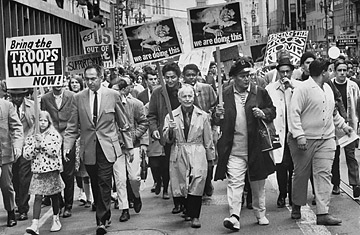
Vietnam War protesters carrying antiwar signs march in San Francisco from Market Street to Golden Gate Park's Kezar Stadium for a rally called Spring Mobilization to End the War in Vietnam
Oct. 7 marks the eighth anniversary of the U.S. invasion of Afghanistan — a war that has slouched from campaign to crusade to near quagmire as the U.S. has rethought and redefined its strategy in the war on terrorism. According to a recent CBS/New York Times poll, 53% of Americans now say things are going badly for the U.S. in Afghanistan. And few are saying that as vehemently as those who have picked the anniversary as their day to demonstrate. Student organizations on 25 college campuses, along with members of antiwar groups like the coalition Act Now to Stop War and End Racism (ANSWER) and Veterans for Peace are holding rallies on Oct. 7; others have already descended on Washington. On Oct. 5, 61 people were arrested in a demonstration in the capital, including Cindy Sheehan, the onetime face of the Iraq antiwar movement, who chained herself to the fence of the White House.
Demonstrations such as these against the nation's military adventures have cropped up at nearly every important conflict in U.S. history. The Peace Democrats of the 1860s became pejoratively known as Copperheads — after a Southeastern snake that attacks without warning — for their opposition to the Civil War. Peace Democrats were mainly recent settlers of the Midwest (Ohio, Indiana and Illinois) with Southern roots and an interest in maintaining the Union, and they made common cause with Northern groups who opposed emancipation and the draft. The antidraft riots of 1863 — dramatized in the 2002 Martin Scorsese film Gangs of New York — were sparked by opposition to the government's recently passed Conscription Act and, in part, by fears among Irish immigrants that freed slaves would come North and take away jobs.
Conscription played a recurring role in protests for the next century. At the start of World War I, Socialists and isolationists opposed the draft on the grounds of civil liberties: Charles Schenck, the general secretary of the Socialist Party of America, was convicted of violating the Espionage Act of 1917 for distributing leaflets that urged men to resist the draft. In the famous case Schenck v. the United States, Schenck argued (unsuccessfully) that conscription was the equivalent of "involuntary servitude" and thus prohibited by the 13th Amendment.
World War II proved less of a platform for antiwar activists; the surprise attack on Pearl Harbor coupled with the global effort to halt fascism and a determination to pull the country out of the Great Depression combined to limit antiwar sentiment. Vietnam, however, was an entirely different ballgame. Unpopular from the start, the war incited the most vocal and widespread antiwar sentiment in U.S. history. Draft-dodging, protests and the burning of draft cards and American flags abounded in a protest movement that had something for everyone. Young adults from middle-class backgrounds — hippies — allied with working-class opponents of the war who felt that an expensive war in a foreign land did not serve their interests. Antiwar protests built on the momentum of the civil rights movement and borrowed many of its nonviolent tactics: among the iconic images from the time are flowers in guns, Abbie Hoffman and the Chicago Seven at the 1968 Democratic National Convention, sit-ins, bed-ins, peace-ins and the ubiquitous peace sign. The 1970 shooting deaths of four students at Kent State University during a protest against the invasion of Cambodia became a rallying cry (and the inspiration for Neil Young's haunting song "Ohio").
Not until George W. Bush ordered the invasion of Iraq in 2003 did the peace movement come near the level of anger that defined the Vietnam War. Sheehan held vigil outside President Bush's Texas ranch, demanding an audience with the man who ordered the war in Iraq that killed her 24-year-old son. Michael Moore's 2004 documentary Fahrenheit 9/11 created a firestorm of antiwar and anti-Bush sentiment, while thousands of civilian protesters have staged "die-ins" in Washington and across the country to give a vivid picture of the costs of the Iraq war. As that conflict appears to draw to a close, however, the U.S. military is again focusing on Afghanistan. And as it does, those who want the war over are not far behind.
